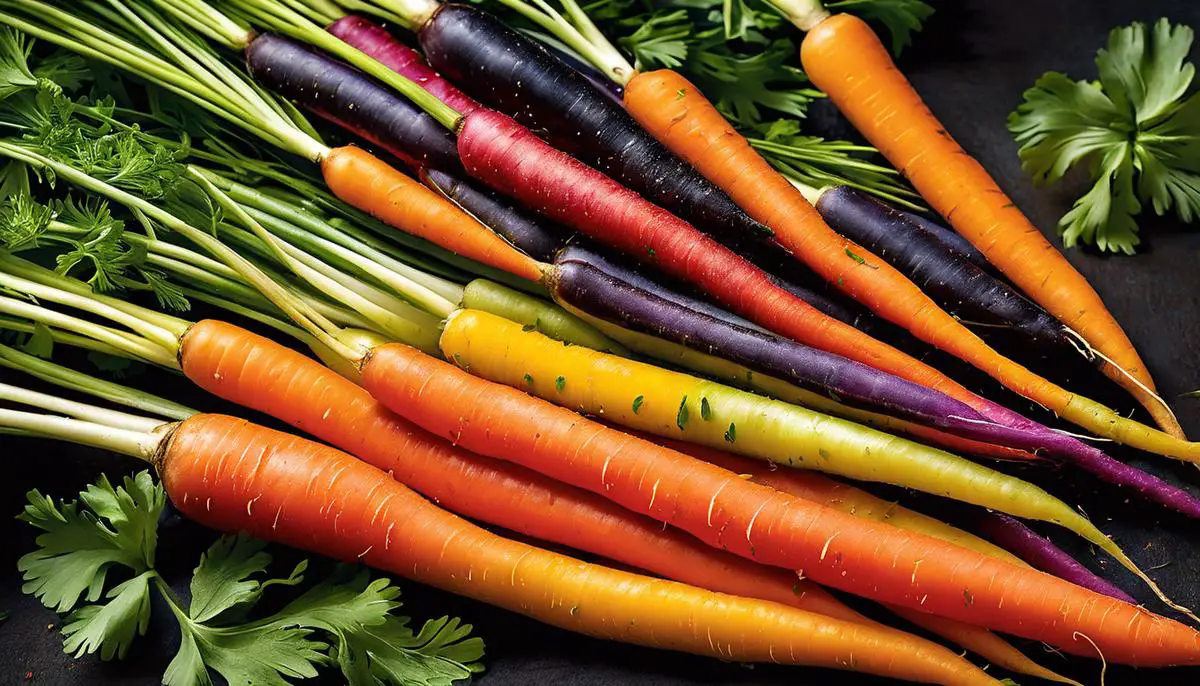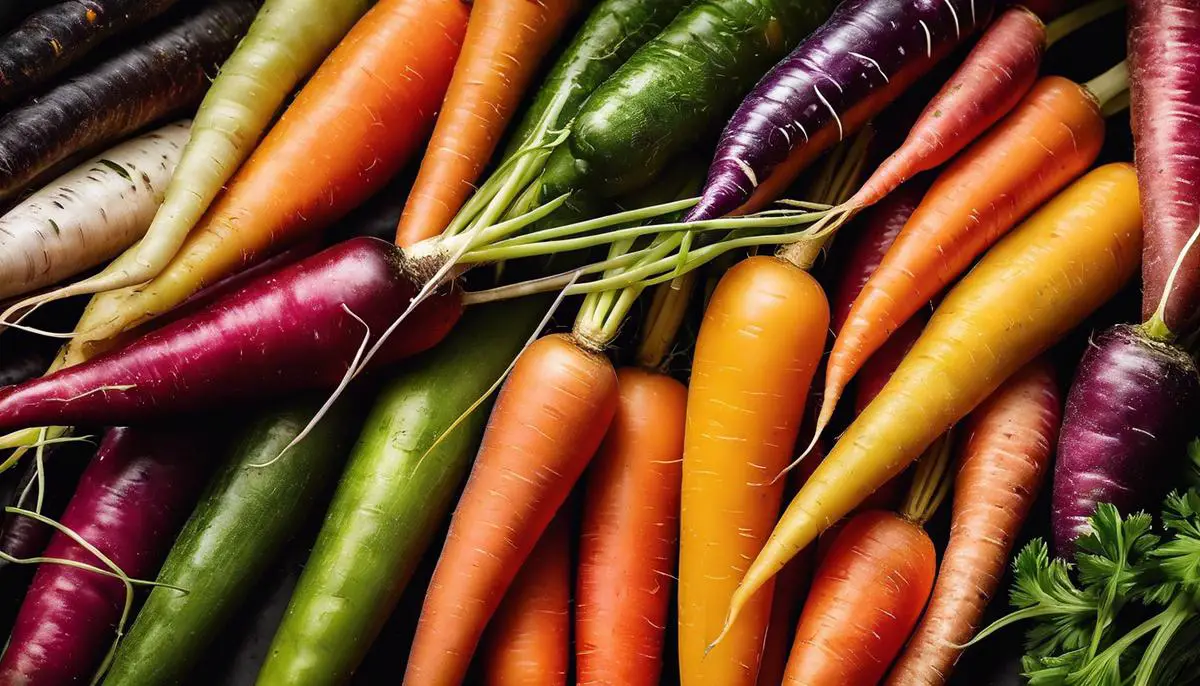Ever wondered how to add a splash of color to your vegetable garden and kitchen dishes in one stroke? Rainbow carrots, with their array of vivid hues ranging from traditional orange to purple, red, yellow and even white, serve as both a visually striking and nutritious option. These variants not only provide a rich source of vitamins, minerals, and fiber but also entail different requirements in terms of growth habits and planting. This informative piece will guide you through the exciting journey of understanding the nature of rainbow carrots, their unique planting procedures, and how to care for and harvest them effectively.
Understand the Nature of Rainbow Carrots
Rainbow Carrots: Masterpieces of Nature, the Multi-Color Charm in Root-Vegetable World
If curiosity is a seed, our magical world of hobbies is a thriving garden fluffy with colorful blossoms. And speaking of gardens, there’s one particular root vegetable that stands out. Enter the vibrant and bewitchingly variant universe of rainbow carrots. Yes, they’re not mythical. They’re gloriously real, offering a palette of colors and a fusion of flavors that outshine regular carrots in more ways than one.
Reader Poll: What online courses would interest you?
First things first – what makes rainbow carrots so different? Some might say it’s just about the color, but hey, it’s so much more than that.
Colorations & Cultivation
The vibrant colors aren’t mere aesthetics; they’re a manifestation of the rich diversity of nutrients. Each hue symbolizes a different nutrient profile, thanks to selective breeding that stattled around the 17th century. For instance, purple carrots carry anthocyanins, beneficial antioxidant properties, while red ones brim with lycopene, celebrated for promoting heart health.
Rainbow carrots also capitalize on hardiness and adaptability, exploring better resistance against diseases and pests than regular carrots. They fare well across a wide range of climates, from cool early spring to the chills of fall, giving hobbyist growers a longer time to enjoy their cultivation.
Subscribe to our newsletter!
Flavors & Nutrition
Bite into a rainbow carrot, and you’ll experience an exciting symphony of flavors. Purple carrots offer a sweet, peppery composition, while yellow ones dance with mild sweetness, and red bring in a traditional carrot flavor with an enhanced sweetness.
Rainbow carrots aren’t just a sight for sore eyes, they pack a punch nutritionally too. They’re a pot of gold at the end of a rainbow, each color offering unique health benefits. Reds are rich in beta-carotene, similar to orange carrots, while antioxidant-rich purples support the immune system, and mellow yellows provide lutein for excellent eye health.
Physical Properties
Visually striking, rainbow carrots defy their mundane counterparts with not just varied exteriors, but also vibrant cores with unique color striations. While the length and shape vary little from regular carrots, their diameter can sometimes be smaller.
Culinary Applications
In the culinary world, rainbow carrots are a coveted ingredient, injecting color and nuanced flavors into dishes. They serve as glorious additions to salads, stir-fries, and roasted vegetable platters, retaining their stunning hues even after cooking. No wonder chefs around the globe love to play around with rainbow carrots to add an exciting twist to their creations.
So, there you have it. Rainbow carrots are not just about an unexpected splash of color in your garden, they are fascinating members of the vegetable kingdom that command admiration. They are a testament to nature’s psychedelic artistry, a burst of nutrition, and a flamboyant character that distinguishes them from their regular cousins. Try them out, and you would never look at the humble carrot in the same way again. Truly, in the world of root vegetables, rainbow carrots are the rock stars!

Steps in Planting Rainbow Carrots
Diving straight into the heart of our conversation, let’s talk about how to plant and grow these vibrant, multicolored wonders. Growing rainbow carrots isn’t much different from cultivating your standard orange variety, but the beauty and variety they bring to your garden – and plate! – makes the experience all the more enjoyable.
Start by choosing the right location. Rainbow carrots, much like their traditional counterparts, need a good amount of sunlight. They thrive best in places that offer six hours of sunlight per day. Also, consider picking a spot with loose, well-drained soil. If your soil is heavy clay or rocky, you may end up with stunted or forked carrots…and we don’t want that!
Once you’ve selected the perfect location, it’s time for some groundwork (pun intended!). Begin by weeding the area thoroughly. Carrot seedlings particularly appreciate a clean bed, as they don’t have to compete with weeds. Once that task is complete, amend the soil using organic compost to enhance fertility. This step all but guarantees that your rainbow carrots will burst forth in vibrant, healthy hues.
The right timing for rainbow carrot planting is another critical aspect to focus on. These delectably hued garden dwellers typically prefer cool temperatures. The best time to plant them is a couple of weeks before the last frost of the season, or in the late summer for a fall harvest. Planting times can fluctuate based on your region’s climate, so always keep that in mind.
Now that you’ve prepped your bed and the time is right, the real fun begins! Sow the rainbow carrot seeds directly, spacing them about 1-2 inches apart in rows that are 12-24 inches apart. Carrots are notorious for their tiny seeds, which can be difficult to handle. A tip here is to mix the seed with some coarse sand for easier sowing. Following planting, cover the seeds with a thin layer of soil and water them gently.
Next up: patience and persistence. Keep the soil moist, especially during the 2-week germination period, ensuring that the soil never dries out completely. It’s also a good practice to apply a thin layer of mulch to retain soil moisture and inhibit those pesky weeds.
Around two weeks after the seedlings emerge, it’s time for the first thinning. This is performed when the seedlings are about an inch tall. The idea is to remove extra plants to give the remaining ones enough space to grow properly. Aim for a spacing of roughly 2 inches between each carrot.
Your finale arrives around 60-70 days after sowing when the rainbow carrots are mature and ready to be harvested. The best indication of a ripe rainbow carrot is its diameter – they’re usually ready when they’re about ½ to 1 inch in diameter at the soil surface. To harvest, gently pull or dig up the carrots, taking care not to damage them in the process.
And there you have it – a wealth of color, right from your garden to your kitchen! Nowhere else will you find such joy and vibrant life than in the process of growing rainbow carrots. So here’s to happy gardening and even happier eating!

Care and Harvest of Rainbow Carrots
Diving Right into Rainbow Carrot Nurturing and Harvesting
A garden filled with rainbow carrots is quite the sight, with an array of hues peeking through teeny cracks in the soil! As fascinating as their cultivation process is, the best part is getting your hands dirty and watching those rainbow roots thrive. So let’s proceed to the practical aspect of nurturing and harvesting these colorful delights.
The first order of business is choosing the appropriate spot for growing: a sunny plot with loose and well-drained soil is ideal. Heavy, compacted soil can be a put-off for those delicate taproots. If blessed with clayey soil, don’t panic! A raised garden bed will do the trick, offering a manageable zone with appropriate depth.
Preparation comes next: enrich your soil to meet the rainbow carrot’s nutrient requirements. Start off by removing stones and large debris. Amend the soil with organic compost, which provides an abundance of nutrients and ensures good water retention yet appropriate drainage. Aim for a pH range between 6.0 and 7.0, ideal for most root vegetables.
When it comes to seeding, timing is paramount. Rainbow carrots develop best in cool temperatures – ideally, 60-75°F. Try sowing in late spring for a summer harvest or late summer for a crop in autumn. Sow the seeds about 1/4 inch deep and 2 inches apart in rows, to allow for optimal growth.
Juggling between too little and too much water – carrot seeds require a crucial balance. Maintain consistent moisture until germination, roughly between 14-21 days. Never allow the surface to dry out – this can be avoided by using a light cloche or sprinkling a thin layer of grass clippings to retain soil moisture.
As your seedlings start emerging with their feathery leaves, give them room to breathe. It’s time to thin the young plants to one every 3 inches. Crowded carrots can lead to stunted growth or peculiarly shaped roots. Thinning may seem heart-wrenching, but it’s in the best interest of your rainbow crop.
Wait for the right moment before harvesting your rainbow carrots. How to tell? Ideally, it’ll take between 50-80 days after planting, depending on the variety. The best indicator is a peek at their shoulder diameter – when it’s around 1/2 to 3/4 inch in diameter, you’re good to go! Harvested too early, and you’d miss out on its optimum flavor; too late, and the texture turns woody.
Finally, the moment of truth. Dig gently around the tops and pull. Voila! Your garden is transformed into a vibrant canvas. Once harvested, rinse off the soil, cut off the tops, and store your rainbow carrots in a cool, humid space.
Remember, the beauty of rainbow carrots goes beyond their stunning shades; they’re a testament to patience, skill, and the magic of horticulture. Unlock the true potential of your garden – and your rainbow carrots will thank you with a pop of color and a burst of flavor!

Ultimately, mastering the cultivation of rainbow carrots does more than just brightening up your dinner plate. By being privy to the right soil types, prudent timing for planting, seed sowing methodologies, and optimal watering practices, you can ensure a successful and bountiful growth. Once you comprehend the ins and outs of feeding, watering and pest management, you have overcome the biggest hurdles. Knowledge, fully equipped, is power. Planting, raising, and harvesting your very own rainbow carrots isn’t just about food, it’s about revitalizing a connection with the earth and spicing up your culinary experiences. So roll up those sleeves and take one step towards self-sufficiency with an array of colors borne from the humble carrot.

